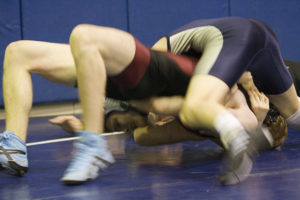January 25, 2017
Athletic trainers are one of the first lines of defense when it comes to sports-related skin infections
 We are in the middle of the high school wrestling season. The wrestling season can be a busy time for licensed athletic trainers (LATs). Due to the amount of physical contact between athletes, wrestling is the most common sport for skin conditions to occur. LATs are one of the first lines of defense when it comes to skin infections. Athletic trainers have knowledge in preventing, assessing, treating, and educating athletes regarding skin conditions.
We are in the middle of the high school wrestling season. The wrestling season can be a busy time for licensed athletic trainers (LATs). Due to the amount of physical contact between athletes, wrestling is the most common sport for skin conditions to occur. LATs are one of the first lines of defense when it comes to skin infections. Athletic trainers have knowledge in preventing, assessing, treating, and educating athletes regarding skin conditions.
What are skin conditions?
Skin conditions are infections of the skin and the layers of soft tissue beneath the skin. These conditions are caused by either a bacterial, fungal, or viral infection. Skin conditions are highly contagious and can be transmitted through skin to skin contact or through direct contact with an already contaminated surface. Skin conditions can appear anywhere on the body.
Common skin conditions
Three of the most common skin conditions seen in wrestling are methicillin resistant staphylococcus aureus (MRSA), impetigo, and tinea corporis (ringworm). MRSA is a bacterial infection that appears as small lesion which when left untreated can progress into larger abscess. Impetigo presents as small red sores that are filled with fluid. These sores can break open which leads to a yellowish brown crust to develop. Ringworm appears as a red ring with raised boarders.
It is important to see a healthcare professional early on if you believe you have any of these conditions. Beginning treatment early will decrease the risk of transmission. Treatment can vary from a topical cream to an oral medication.
Return to participation
The Wisconsin Interscholastic Athletic Association (WIAA) and the National Federation of State High School Associations (NFHS) have rules and guidelines about when an athlete can return to competition following contracting a skin condition. Most athletes who have contracted a skin condition will have to sit out of competition for at least 72 hours after starting treatment. Once the 72 hours have passed and no new sores have developed, the athlete may return to participation. The sores that are still present must be covered appropriately during all athletic participation.
Prevention Tips:
- Shower after each practice or competition
- Do not share towels or other personal hygiene products
- Wash practice clothes and uniform after each use
- Clean equipment daily
- Do not share equipment such as head gear
- Inform your coach, parents, and a healthcare professional if you notice any skin sores
- Do not use a whirlpool or cold tub if you have any open wounds.
Prevention is the most important factor when it comes to decreasing the spread of skin conditions. By having good personal hygiene and clean equipment the risk of contracting a skin condition is greatly reduced. By following the above prevention tips you can decrease your chances of contracting a skin condition and have a healthier wrestling season.
For more information about skin conditions, you can contact a Licensed Athletic Trainer at the Fort HealthCare Therapy and Sport Center at 920-563-9357, or call the sports medicine information line at 920-568-6560.
